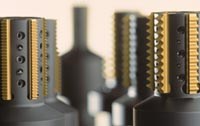Increase Productivity and Tool Life with Thread Milling
Because of greater productivity and cost savings, thread milling offers advantages to moldmakers and should be considered as an alternative to tapping.
Thread milling is one of the fastest growing technologies in the metalcutting industry because of its superior productivity and cost savings potential. But thread milling also offers advantages to the mold industry, such as its ability to reliably make precision holes, even in hardened materials.
AccuracyIn the past, a threaded hole would be tapped before hardening. Using thread milling for parts in their hardened stage produces precision threads with more accurate thread location. When using a mold, a hole must be drilled and then tapped. When the mold is heat treated, the tapped hole can move slightly, affecting the accuracy. When thread milling hard material, the hole is already in the mold, so it is possible to achieve a perfect hole with perfect dimensional accuracy. Sometimes a moldmaker receives material that has already hardened, making it very difficult to tap. In this situation, the mold would be drilled, followed by forming the thread with a thread mill. Problems often arise, because tapping can cause stress that can crack the material, or the tap can break in the mold. The tap must be removed, which is a costly operation. On the other hand, when a thread mill breaks it takes about five to 10 minutes to replace. For example, a 0.005-inch oversize tap might be used to compensate for the expected shifting that occurs in the mold after the hardening process. In some cases, the tap would have to go through the hole again to clean the thread after the hardening process. When using thread milling, mold material is received in the hardened state, while tapping puts much more stress on the cut. Making tapered threads (NPT or NPTF) for sealing is a common practice in the mold industry. Tapping tends to tear threads and taps break more easily because of the tapered hole. Thread milling makes a high-quality, precision-tapered thread that, in some cases, creates a seal so that pipe sealant or Teflon tape is not needed for thread connection. Another advantage to using a thread mill to make tapered threads is the ability to repeatedly achieve the same start point for the thread, so that connection tees that fit into threaded holes always repeat to the same location. Longevity and ReliabilityThread mills offer excellent longevity and reliability. Thread milling can potentially offer a 500-percent increase in tool life over tapping. Typically, when forming an NPT tapered thread, a hole must be pre-formed using a taper reamer, followed with a taper tap to form the required thread. This is a difficult and slow process compared to thread milling, where the hole and the thread are formed in just one operation. Thread milling provides the moldmaker complete control over quality threads with a reliable process. Several other factors make thread milling the more economical choice. Large taps require expensive, high-power machines that are capable of generating enough power to produce the tremendous pressure needed to drive the taps into the work. But because the chip load is low in thread milling, the process can work on lighter-duty machines, even when the holes are big. Thread milling also works in a variety of holes with a much smaller inventory of tools. A thread mill with a certain pitch can produce that pitch in any hole by simply programming the machine to run a larger cutting diameter, whereas tapping requires the correct tap for each hole. ProductivityThread milling's contribution to productivity makes it especially appealing to mold manufacturers. Taps are prone to break inside the part-especially in hardened or difficult-to-machine materials-due to the high cutting forces and pressures generated in the cut. Having to burn broken taps out with an EDM can blow the cycle-time advantage. Depending upon the material (steel, high-tap alloys, stainless steels, cast iron, etc.), a broken tap can take as much as four hours away from production. Thread mills not only break less often, but they can be replaced in about 10 minutes when they do. A thread mill does not jam up in the hole, it drops to the bottom, where it can be removed and replaced with a new one. Moreover, the work stays in the machine, eliminating the risk of introducing locating errors that can occur when reclamping it in the machine after the EDM removes the broken tap. The larger the hole, the faster the cycle time is for thread milling. SafetyThe mold industry's concern for safety, specifically in the threaded connections for eyebolts used for lifting, is another reason for the growing popularity of thread milling. Traditionally, manufacturers tapped the holes for inserting eyebolts in molds. Tapping was considered the simplest and most efficient way to obtain threaded holes. Because of the forces necessary to push large taps through properly sized holes, especially in hard materials, there was a tendency for operators to drill the hole oversize in order to make it easier to tap the part. This can result in undercutting the full thread depth in the tapping operation, which can lead to a lack of full thread engagement with the eyebolt threads. In a worst-case scenario, when an eyebolt is inserted into a hole with weakened threads, the bolt may pull out when lifting the mold, causing damage to the mold and injury to operators. Thread milling provides a better alternative to tapping for mold applications because there is no need to drill oversize holes. In fact, in order to get 100 percent thread depth in thread milling, an undersize hole is drilled first. When threading holes are deeper than about 1.5 times diameter, tapping can usually be completed faster than thread milling, which may require multiple passes. However, the programmability and repeatability of thread milling has a direct impact on the quality of threads. |
Related Content
Think Safety: Eliminate Hazards Throughout the Shop
The tooling community is taking advantage of new products for safer mold shops and molding facilities.
Read MoreTackling a Mold Designer Shortage
Survey findings reveal a shortage of skilled mold designers and engineers in the moldmaking community, calling for intervention through educational programs and exploration of training alternatives while seeking input from those who have addressed the issue successfully.
Read MoreSteps for Determining Better Mold Prices
Improving your mold pricing requires a deeper understanding of your business.
Read MoreThe Critical Role of Management Representatives in ISO 9001
In ISO 9001 quality management systems, the Management Representative (MR) plays a crucial role. While the 2015 version of ISO 9001 no longer mandates this position, having a trusted management member serve as an MR remains vital for streamlining operations and maintaining quality standards.
Read MoreRead Next
Internal Threading Made Easy
New advances in thread milling technology allow moldmakers to meet the challenges of threading difficult materials.
Read MoreAre You a Moldmaker Considering 3D Printing? Consider the 3D Printing Workshop at NPE2024
Presentations will cover 3D printing for mold tooling, material innovation, product development, bridge production and full-scale, high-volume additive manufacturing.
Read MoreReasons to Use Fiber Lasers for Mold Cleaning
Fiber lasers offer a simplicity, speed, control and portability, minimizing mold cleaning risks.
Read More





















.jpg;maxWidth=970;quality=90)